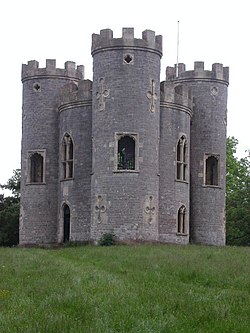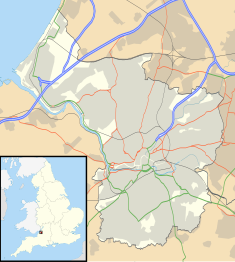Blaise Castle Estate
| Blaise Castle Estate | |
|---|---|
 The folly castle | |
| Location | Bristol, England |
| Coordinates | 51°30′14″N 2°37′55″W / 51.504°N 2.632°W |
| Built for | John Harford (Blaise Castle House) |
| Architect | William Paty (Blaise Castle House) |
| Owner | Bristol City Council |
Listed Building – Grade II* | |
| Official name | Blaise Castle |
| Designated | 8 January 1959[1] |
| Reference no. | 1208115 |
Listed Building – Grade II* | |
| Official name | Blaise Castle House and attached wall |
| Designated | 8 January 1959[2] |
| Reference no. | 1279500 |
| Official name | Blaise Castle and Hamlet |
| Designated | 15 May 1987[3] |
| Reference no. | 1001426 |
Listed Building – Grade II | |
| Official name | Orangery to Blaise Castle House |
| Designated | 8 January 1959[4] |
| Reference no. | 1293345 |
Listed Building – Grade II* | |
| Official name | Model dairy approximately 60 metres east of Blaise Castle House |
| Designated | 8 January 1959[5] |
| Reference no. | 1293355 |
Blaise Castle is a
The site has signs of occupation during the
Early history
Flint fragments show Blaise Castle Estate was probably first inhabited by Neolithic farmers. There is more definitive evidence for Bronze Age, Iron Age and Roman activity through the distinctive hill-forts in the area and other archaeological finds.[3][6] The value of this historic landscape was recognised when it became a scheduled monument in 1982.[7]
The land was granted to the
The chapel's last ruins were removed in 1707.[13]
Blaise Castle House

In the later 18th century, the estate was owned by a sugar merchant and investor in the
The elder Harford also had Blaise Hamlet built to house his servants and tenants, to designs of Nash and George Repton, in 1811.[22] The estate was sold to Bristol City Council in 1926, to preserve it from development.[20] During World War II the house was occupied by the armed forces.[9] A branch of the Bristol City Museum and Art Gallery since 1949, Blaise Castle House now features collections relating to household items in addition to its period interior decoration.[20] Galleries have displays of historic domestic equipment used for lighting, cooking, cleaning, washing, including a display of toilets.
Blaise Castle
On a hill above the gorge is a sham castle in Gothic Revival style overlooking Bristol, Avonmouth and the Avon Gorge, with views across to South Wales on a clear day.[23] It was built in 1766, by Robert Mylne, on the site of a chapel dedicated to Saint Blaise.[1][24] The folly is reputed to have cost £3,000.[12] The circular building is built of local ashlar stone with limestone dressings. It has three turrets with crenellated parapets.[1]
Denham Skeate opened the site to the public.[13]
It was open to paying visitors and a popular attraction from the first with excellent views on a clear day. Vessels could be seen passing on the
It was inhabited into the 20th century and was elaborately decorated internally. It is a Grade II* listed building and was restored in 1957.[26][1]
Blaise Hamlet

The hamlet was designed by
The estate

The castle and its 650 acres (2.6 km2) of parkland are now open to the public.
The grounds were laid out by Humphry Repton (1752–1818) a leading landscape gardener.[3] Parts of Repton's designs still exist, notably the carriage drive which winds its way from the house, sections of which follow the original route. In addition to the conservatory and the almshouses in Blaise Hamlet,[20] Nash built the limestone dairy in 1802.[5]
The grounds include a gorge cut by the Hazel Brook through Bristol's limestone. The gorge has a number of landscape features, including Goram's Chair, a limestone outcrop often used by climbers, and Lover's Leap and Potter's Point, two panoramic viewing spots. Stratford Mill was moved from West Harptree and re-erected within the gorge after Chew Valley Lake was flooded to form a reservoir.[23] Ongoing renovations started in 2004 of the mill, settling ponds and associated estate pathways. At the gorge's southern end, Hazel Brook joins the River Trym, which continues its flow towards Sea Mills. Other features within the estate include two pools: the Giant's Soapdish and the Penny Well, and two caves: the Robber's Cave and the Butcher's Cave.[3]
Kings Weston Hill, to the west of the castle, also forms the part of the estate which is close to Kings Weston Roman Villa.[35]
See also
- Blaise Hamlet
- Bristol Museum & Art Gallery
References
- ^ a b c d "Blaise Castle". National Heritage List for England. Historic England. Retrieved 26 February 2017.
- ^ a b c "Blaise Castle House and attached wall". National Heritage List for England. Historic England. Retrieved 26 February 2017.
- ^ a b c d e f g h "Blaise Castle and Hamlet". National Heritage List for England. Historic England. Retrieved 9 April 2017.
- ^ a b "Orangery to Blaise Castle House". National Heritage List for England. Historic England. Retrieved 26 February 2017.
- ^ a b "Model dairy approximately 60 metres east of Blaise Castle House". National Heritage List for England. Historic England. Retrieved 26 February 2017.
- ^ "History". Friends of Blaise. Retrieved 26 February 2017.
- ^ "Blaise Castle, Iron Age hillfort, Roman and medieval remains, and post-medieval garden". National Heritage List for England. Historic England. Retrieved 26 February 2017.
- ^ a b c "Blaise Castle, Bristol, England – History". Parks and Gardens UK. Parks and Gardens Data Services Ltd. Archived from the original on 27 February 2017. Retrieved 26 February 2017.
- ^ a b "History of Blaise Castle estate" (PDF). Film Bristol. Archived from the original (PDF) on 27 February 2017. Retrieved 26 February 2017.
- ^ "Blaise Castle Estate". BBC. Retrieved 8 April 2017.
- ^ "The History of Blaise Estate". Bristol Museums. Retrieved 26 February 2017.
- ^ a b c d e Cooke 1957, p. 147.
- ^ a b Lane, Maggie (1985). "Blaise Castle". Jane Austen Society of North America- Persuasions. pp. 78–81. Retrieved 7 January 2022.
- ^ a b Jenkins 2003, p. 683.
- ^ Shiercliff, E (1789). The Bristol and Hotwell Guide. p. 77.
- ^ "Blaise Estate". Boddy Parts. Archived from the original on 2 March 2007. Retrieved 8 January 2022.
- ^ a b c d Foyle 2004, p. 288.
- ^ Cooke 1957, pp. 148–149.
- ^ "Blaise Castle House and attached wall". historicengland.org.uk. Historic England. Retrieved 13 March 2007.
- ^ a b c d e Jenkins 2003, p. 685.
- ^ "Picture Room". Bristol Museums. Retrieved 26 February 2017.
- ^ "The history of Blaise Hamlet". National Trust. Retrieved 8 April 2017.
- ^ a b c Foyle 2004, p. 289.
- ^ "Blaise Castle Estate". Brisray. Retrieved 26 February 2017.
- ^ Wenner 2016.
- ^ "Blaise Castle". historicengland.org.uk. Retrieved 13 March 2007.
- ^ "The history of Blaise Hamlet". National Trust. Retrieved 8 August 2016.
- ISBN 978-1-58093-326-1.
- ^ Wilson, Vicky. "Photograph of the Circular Cottage, Blaise Hamlet, Bristol 1973". Architecture.com. Archived from the original on 18 August 2016. Retrieved 8 August 2016.
- ISBN 9780300187847.
- ISBN 978-1-61091-109-2.
- ^ "Blaise Hamlet, Bristol, England - Description". Parks and Gardens UK. Parks and Gardens Data Services Ltd. Archived from the original on 10 August 2016. Retrieved 8 August 2016.
- ^ "Blaise Hamlet, Bristol, England - History". Parks and Gardens UK. Parks and Gardens Data Services Ltd. Archived from the original on 10 August 2016. Retrieved 8 August 2016.
- ^ "Blaise Castle Estate". BBC. Retrieved 26 February 2017.
- ^ "Kings Weston Roman Villa". Bristol Museums. Retrieved 26 February 2017.
Bibliography
- Cooke, Robert (1957). West Country Houses. Batsford.
- Eveleigh, David (1987). A Popular Retreat: Blaise Castle and House Estate. City of Bristol. ISBN 978-0-900199-35-6.
- Foyle, Andrew (2004). Bristol (Pevsner Architectural Guides: City Guides). Yale University Press. ISBN 978-0-300-10442-4.
- ISBN 978-0-7139-9596-1.
- Wenner, Barbara Britton (2016). Prospect and Refuge in the Landscape of Jane Austen. Routledge. ISBN 978-1-351-90823-8.
- Richmond, Joan M (2015) Nine Letters from an Artist The Families of William Gillard, Porphyrogenitus. ISBN 978-1-871328-19-6.

